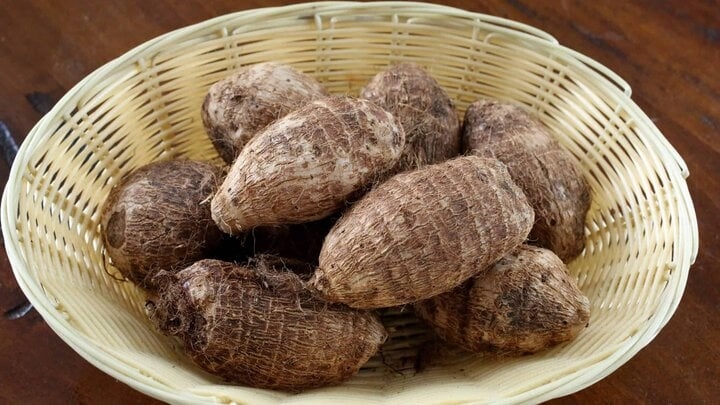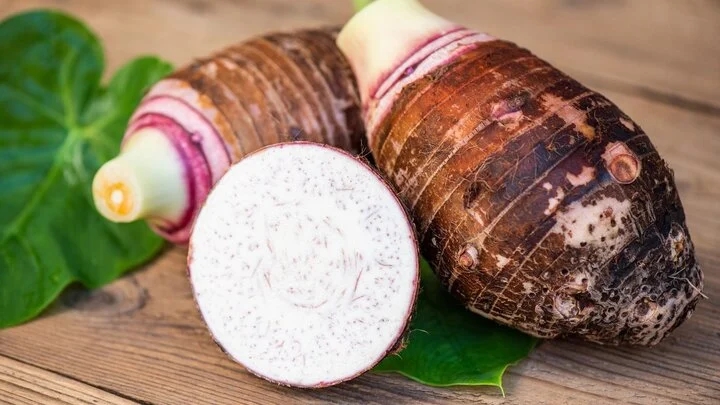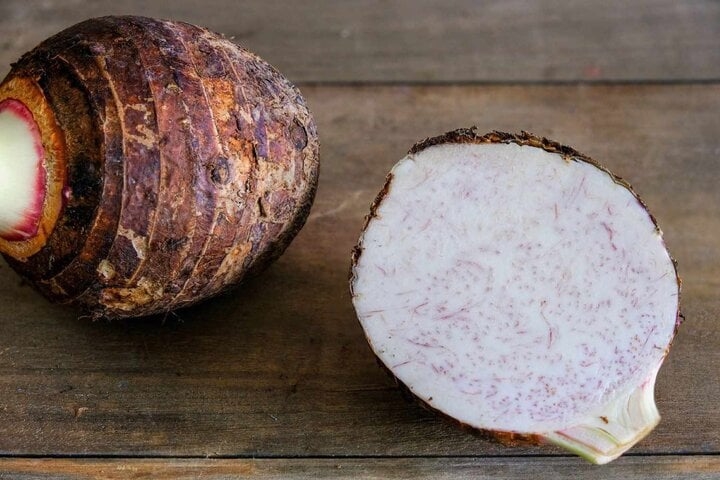Taro is a very healthy food and there are many ways to prepare it, creating dishes that many people love. You can use it for frying, boiling, stewing, making soups, making desserts, or making cakes, all of which are delicious.
Is it better to choose large or small taro when buying?
If you are not careful when buying, you may choose low-quality tubers that are not tasty. One of the concerns raised by many people is whether to choose large or small taro.

Choosing whether to choose large or small taro is something that many people are uncertain about. (Photo: Maangchi)
The weight of taro tubers is one of the important criteria for choosing this food. In general, when buying taro, we should choose tubers that are light to hold. According to the experience of growers, light taro tubers will contain less water and have a high starch content, usually become firm and fragrant. The heavy tubers contain a lot of water, the taste is usually very bland, easy to decay, and not tasty.
Therefore, you don’t need to worry too much about whether to choose large or small taro, pay more attention to the weight of the taro tuber.
Tips for buying delicious taro

To buy delicious taro, you also need tips. (Photo: Eater)
In addition to being based on weight, paying attention to the following factors can also help you choose taro that is delicious as desired.
Look at the appearance
When choosing taro, you should observe the external shape of the taro tuber. Since taro is dug up from the ground, they often have soil attached to the outside. If there is still soil attached to the surface and the soil is relatively moist, it means that the taro has just been dug up and is still very fresh. If the surface of the taro is not dirty or the soil has dried out, it means that the taro has been stored for a long time, the flesh inside may have dried out a bit. These tubers often rot easily.
Look at the eyes of the taro
The depressions on the taro tuber are the eyes of the taro. Whether taro is delicious or not directly related to the number of eyes. The more eyes there are, the softer, pungent, and delicious the taro tubers are.
On the other hand, taro tubers with few or no eyes are often not tasty.
Color and texture of the taro

When cutting taro in half, if you see more purple veins, it means that it is delicious taro. (Photo: Storables)
Large taro tubers are usually cut in half for sale. At this time, you can observe the cut surface of the taro, if you see white color intertwined with many light purple veins, it means that the taro is delicious. On the contrary, if the color inside is pale, the veins are sparse, then the taro will usually not be delicious, so you shouldn’t choose to buy it.
In addition, you can also lightly scratch the taro with a knife. If a little white, murky liquid flows out at the scratch mark, and when you touch it lightly with your hand, the sticky substance quickly dries, then this is a taro with a lot of starch, high quality.
The effects of taro on health
Taro is one of the highly nutritious yams, with many health benefits:
Improving digestive health
One of the biggest benefits of taro is its ability to stimulate digestive activity. Taro contains a large amount of fiber, which is very helpful in supporting a healthy digestive system.
Taro also helps prevent issues such as bloating, indigestion, flatulence, constipation, and even diarrhea. A healthy digestive system can enhance overall health and reduce the risk of cancer.
Preventing cancer
Taro has natural polyphenols, which are natural antioxidants, and has many health benefits, including cancer prevention.
Quercetin is the main polyphenol found in taro, and is also an important component of apples, onions, and tea. Quercetin can inhibit the growth of cancer cells. It has antioxidant properties, supports apoptosis, and inhibits the proliferation of cancer cells at different stages.
Moreover, taro also contains cryptoxanthin, which can prevent throat and lung cancer.
Balancing blood sugar levels
People who consume low-glycemic index foods will have a lower risk of heart disease and diabetes. Taro has a low glycemic index naturally, which helps diabetes patients effectively control their blood sugar levels.
Taro also supports balancing blood sugar levels, reducing and controlling lipids and triglycerides, thus helping with weight loss and maintaining body mass index (BMI). It has many nutrients such as protein, calcium, thiamine, phosphorus, riboflavin, niacin, and vitamin C to maintain good skin and overall health.
Preventing heart disease
Taro contains a good amount of starch and fiber. Doctors recommend consuming good fiber to prevent cardiovascular and coronary artery diseases. Fiber plays an essential role in reducing LDL – bad cholesterol. The resistant starches in taro reduce insulinemia reactions, improve insulin sensitivity throughout the body, increase food satisfaction, and reduce fat storage.
Boosting immune system
Taro plays an important role in improving immunity, antioxidant, blood sugar lowering, immune regulation, and antibacterial. Antioxidants neutralize free radicals in the body and prevent cell damage.
Supporting weight loss
Taro has an average glycemic index, but it contains a high fiber content, which is a necessary characteristic to support the weight loss process and control blood sugar levels in the body. Additionally, taro provides essential minerals such as magnesium, calcium, potassium, phosphorus, iron, and zinc, as well as beneficial fiber for health. Fiber helps us feel full longer, so we consume fewer calories.
According to VTC news






































